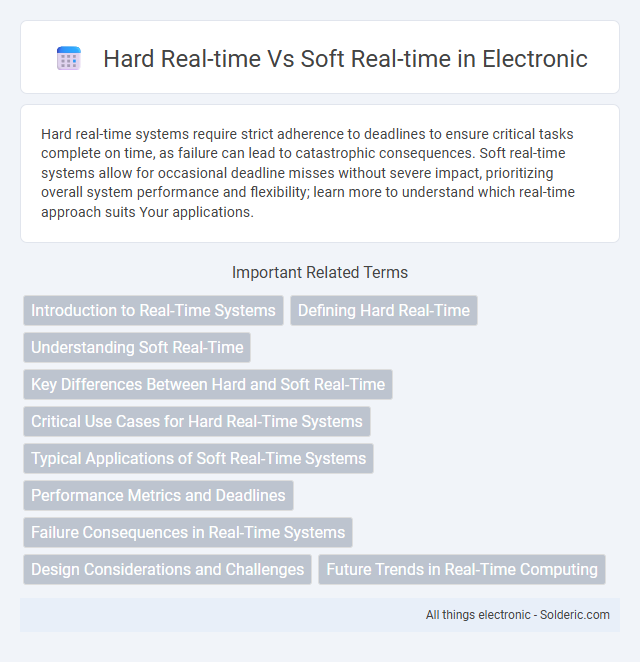Hard real-time systems require strict adherence to deadlines to ensure critical tasks complete on time, as failure can lead to catastrophic consequences. Soft real-time systems allow for occasional deadline misses without severe impact, prioritizing overall system performance and flexibility; learn more to understand which real-time approach suits Your applications.
Comparison Table
| Aspect | Hard Real-Time | Soft Real-Time |
|---|---|---|
| Definition | Strict deadline adherence; failure causes system failure. | Deadlines are important but occasional misses are tolerable. |
| Deadline | Absolute and must be met every time. | Preferable but not mandatory every time. |
| Examples | Airbag systems, pacemakers, industrial control systems. | Video streaming, online gaming, multimedia applications. |
| Consequences of Missed Deadline | Catastrophic failure or system crash. | Degraded performance or quality of service. |
| Task Scheduling | Priority-based preemptive scheduling with strict guarantees. | Flexible scheduling with best-effort approach. |
| System Design | Deterministic and predictable behavior essential. | Focus on average performance and throughput. |
| Resource Allocation | Reserved and guaranteed resources. | Shared resources, dynamic allocation. |
Introduction to Real-Time Systems
Real-time systems process data and events within strict timing constraints, classified into hard real-time and soft real-time categories based on deadline criticality. Hard real-time systems require absolute deadline adherence to ensure system safety, as found in avionics and medical devices, while soft real-time systems tolerate some deadline misses without catastrophic consequences, common in multimedia streaming and online gaming. The distinction influences system design, scheduling algorithms, and resource management to meet timing guarantees effectively.
Defining Hard Real-Time
Hard real-time systems require strict adherence to deadlines where missing a timing constraint can lead to catastrophic failures, making them critical in environments like medical devices and industrial control. These systems guarantee deterministic timing behavior, ensuring that every task completes within a specified time frame. Your applications demanding absolute predictability and reliability must prioritize hard real-time constraints to maintain system safety and functionality.
Understanding Soft Real-Time
Soft real-time systems prioritize meeting deadlines but allow occasional delays without catastrophic consequences, making them suitable for applications like video streaming or online gaming. These systems balance performance and flexibility, ensuring Your tasks usually complete on time while tolerating minor timing variations. Understanding soft real-time involves recognizing that missed deadlines degrade quality rather than cause total failure, emphasizing responsiveness over absolute guarantee.
Key Differences Between Hard and Soft Real-Time
Hard real-time systems require strict adherence to deadlines where missing even a single timing constraint can lead to catastrophic failures, commonly found in medical devices or automotive safety systems. Soft real-time systems prioritize meeting deadlines but allow occasional delays without critical consequences, often used in multimedia streaming or online gaming. Understanding these key differences helps you select the right system based on the tolerance for timing accuracy and potential system impact.
Critical Use Cases for Hard Real-Time Systems
Hard real-time systems are essential in critical use cases such as aerospace control, medical life-support devices, and automotive safety systems where missing a deadline could result in catastrophic failure or loss of life. These systems guarantee deterministic response times, ensuring tasks are completed within strict timing constraints. Soft real-time systems, in contrast, tolerate occasional deadline misses, making them suitable for applications like video streaming and online gaming where timing precision is less critical.
Typical Applications of Soft Real-Time Systems
Soft real-time systems are commonly used in multimedia streaming, online gaming, and telecommunications where occasional delays are tolerable without significant impact on user experience. These systems prioritize timely data processing but allow minor latency variations, making them ideal for applications like video conferencing and mobile communications. Understanding your specific application's timing requirements helps determine if a soft real-time system meets performance and reliability needs effectively.
Performance Metrics and Deadlines
Hard real-time systems guarantee task completion within strict deadlines, with performance metrics emphasizing predictability and worst-case execution time (WCET). Soft real-time systems prioritize average response time and throughput, allowing occasional deadline misses without critical failure. Meeting deadlines in hard real-time requires deterministic scheduling, while soft real-time employs flexible algorithms optimized for overall system performance.
Failure Consequences in Real-Time Systems
Hard real-time systems experience catastrophic consequences if deadlines are missed, such as system crashes or safety hazards, making timely task completion critical. In contrast, soft real-time systems tolerate occasional deadline misses with degraded performance or reduced quality of service without causing system failure. The differing failure consequences drive system design priorities, with hard real-time systems emphasizing strict timing guarantees and soft real-time systems allowing flexible timing constraints.
Design Considerations and Challenges
Hard real-time systems demand deterministic scheduling and rigorous worst-case execution time analysis to guarantee deadline adherence, making system reliability and predictability critical design considerations. Soft real-time systems emphasize flexibility and graceful degradation, prioritizing average performance over absolute deadline compliance, which introduces challenges in balancing resource allocation and system responsiveness. Your approach must account for the complexity of task prioritization, synchronization, and potential fault tolerance mechanisms to effectively manage timing constraints within either paradigm.
Future Trends in Real-Time Computing
Future trends in real-time computing emphasize the integration of AI and machine learning algorithms to enhance predictive capabilities and system adaptability in hard real-time applications, ensuring stricter deadline adherence. Soft real-time systems are evolving with cloud-based solutions and edge computing, enabling scalable, low-latency processing for dynamic environments. Advances in real-time operating systems (RTOS) and hardware acceleration are driving improved determinism and responsiveness across both hard and soft real-time domains.
hard real-time vs soft real-time Infographic

 solderic.com
solderic.com